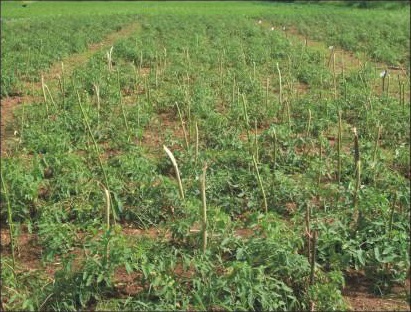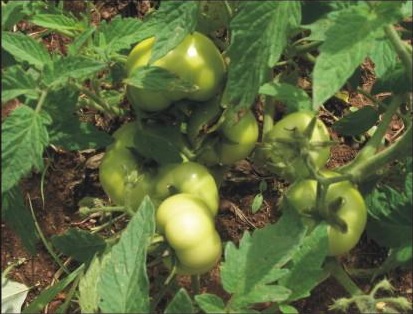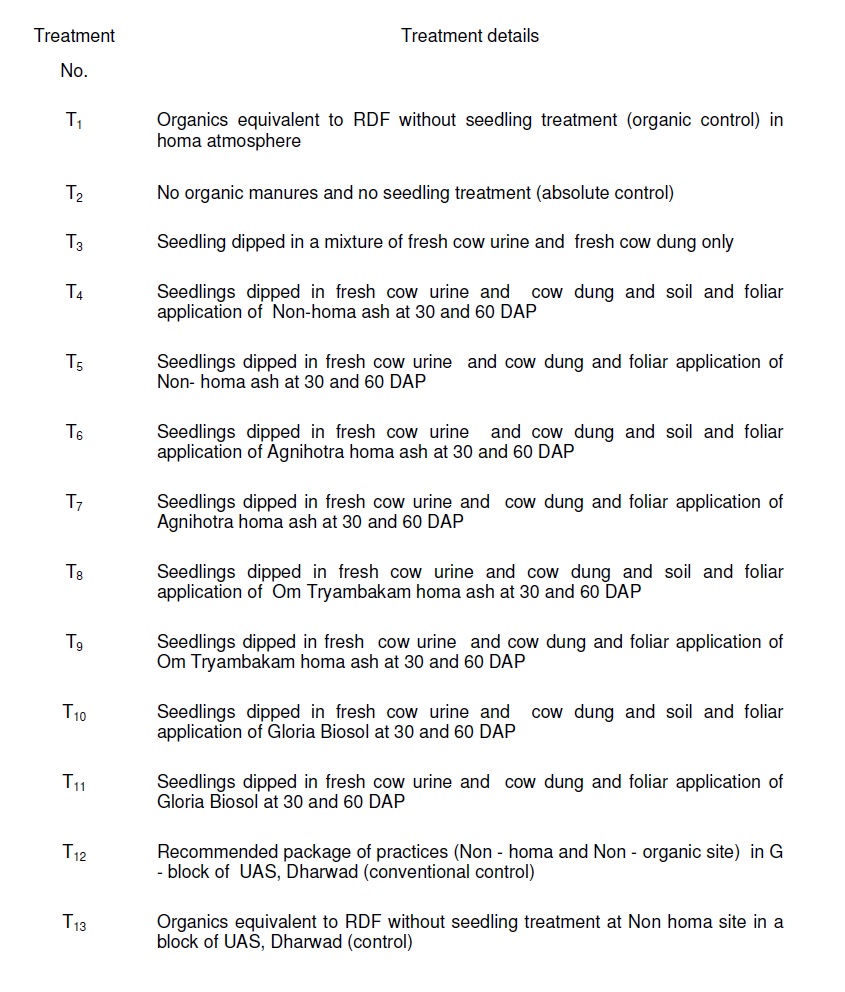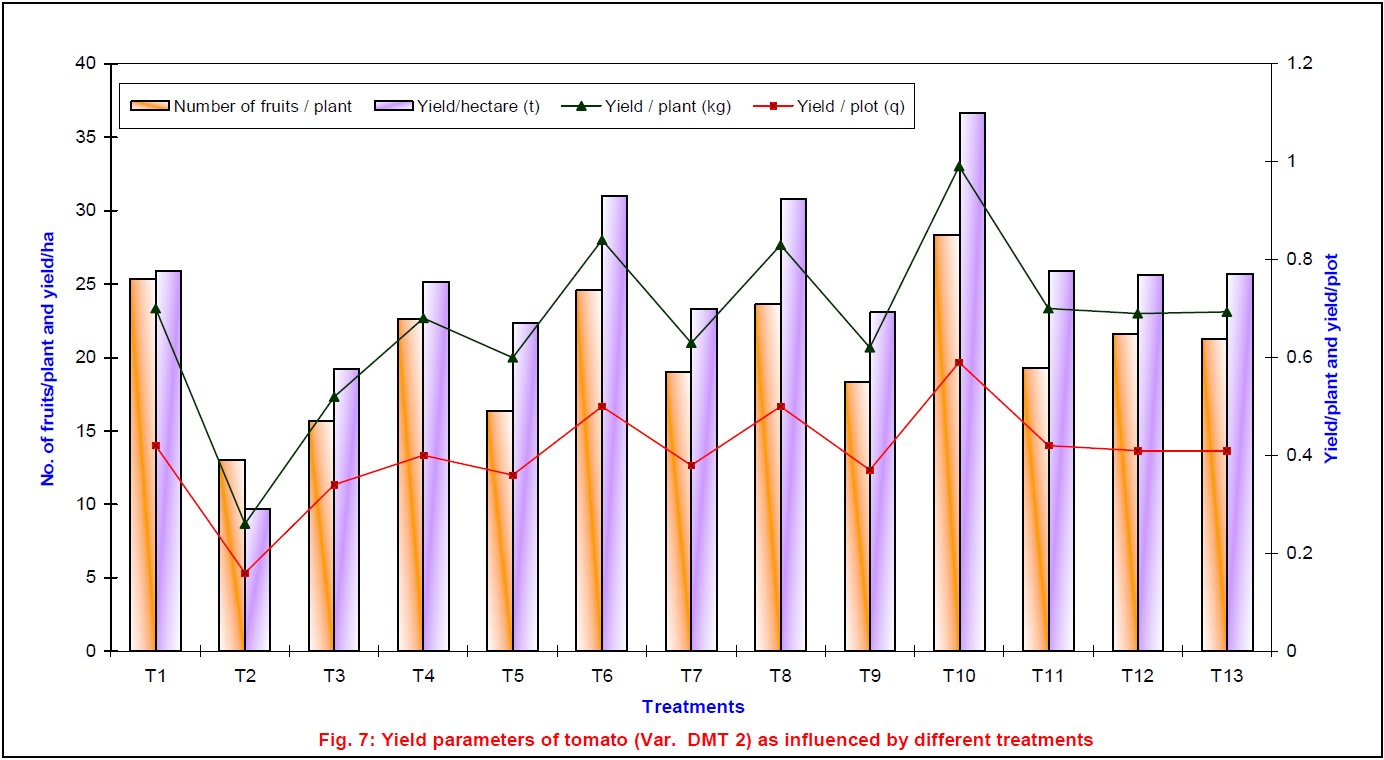An investigation was carried out at Main Agricultural Research station, University of Agricultural Sciences, Dharwad, Karnataka during kharif season 2010, to study response of tomato (Solanum lycopersicum L.) to Homa Organic Farming practices.
Preamble
The field experiment was laid out in completely randomised block design with 11 treatments exposed to Homa atmosphere replicated thrice.
Objectives of Investigation:
To study the effect of Homa organic farming practices on:
- The growth, yield and quality of tomato.
- Chemical properties of soil and soil fertility.
- Beneficial organisms and biological activity in rhizosphere soil.
- The pest and disease management of tomato.
|
 |
 |
|
The conventional control (CC) and control without Homa (CWH) were maintained almost 1 km away. The soil type was sandy loamy. All the seedlings were grown on raised beds, transplanted after one month and were given fresh cow dung and cow urine as basal treatment except absolute control, CC and CWC. Non-homa ash was collected after burning the agricultural waste. Agnihotra homa (AH) was performed at sun rise and sun set and Om Tryambakam homa (OTH) was performed for 3-4 h daily during experimental period which yielded smoke and ash. A special bio-digester called Gloria Biosol was prepared which contained AH ash. The Non-homa ash, AH ash, OTH ash and Gloria Biosol were used for soil and foliar application. |
 |
Discussion
Soil and foliar application of Gloria Biosol was significantly superior over organic control in plant height, number leaves, number of branches, root length, yield attributes, microbial population in the soil, increase in the activities of soil dehydrogenase (5- 52%) and soil phosphatase (2-34%), soil N and K and micronutrients, Cu and Mn and quality parameters like lycopene (40.69%), phenol (7.28%), ascorbic acid (49.05%), TSS (10.2%) and total sugar (9.68%) showed significant increase. Soil and foliar application of AH ash increased soil phosphorus and micronutrients, Zn and Fe. Shelf life of tomato fruits increased by 7-12 days due to different homa treatments as compared to organic and conventional control. Incidence of Leaf spot and insect attack was reduced significantly (37.2% – 40.17%, respectively) due to soil and foliar application of Gloria Biosol which was superior over homa ashes and control. |
 |
Summary and Conclusion
- Morphological characters like plant height, number of branches, number of leaves were enhanced due to different homa treatments as compared to organic control.
- The tomato yield (kg/ha) registered 43 per cent increase as compared to organic control due to soil and foliar application of a special bio-digester called Gloria Biosol.
- Soil and foliar application of Gloria Biosol increased soil macronutrients (N -74 % and K-31 %) and micronutrients (Cu – 28 % and Mn – 29 %) as compared to organic control.
- The soil and foliar application of Agnihotra homa ash increased soil P by 40 per cent and soil Zn and Fe content by about 15 per cent each as compared to organic control.
- The soil and foliar application of Biosol registered increase in the population of bacteria, fungi and Actinomycetes by 18, 48, and 47 per cent, respectively.
- Increase in the activities of soil dehydrogenase (5-52 %) and phosphatase (2- 34 %) due to different homa treatments as compared with organic control was observed.
- Increase in quality parameters like ascorbic acid (49%), lycopene (40%), phenols (7%) and TSS (10%) was found due to soil and foliar application of Gloria Biosol as compared to organic control.
- Decrease in the incidence of leaf spot (37%) and insect attack (40%) was observed as compared with Gloria Biosol and organic control due to different homa treatments.
- Soil and foliar application of Gloria Biosol was more effective than its foliar application alone in improving growth and yield parameters like soil biological activity, macro and
micronutrients like N, K, Cu, Mn and quality parameters like ascorbic acid, lycopene, phenols, total sugars and TSS.
- Soil and foliar application of Agnihotra homa ash was effective in increasing shelf life of the tomato fruits by 7-12 days.
It may be concluded from the present study that Homa organic farming practices not only heal the atmosphere by lowering pest and disease attack but also take care of health of the soil, plants and their produce. |
Thesis details
BRUNDA R. (Author)
M.Sc (Agri) (Degree)
Plant Biochemistry (Department)
University of Agricultural Sciences, Dharwad (Institute)
AC, Dharwad-580005 Karnataka State, India (Place)
2011 (Year submitted)
Th10206 (Accession No)
University Library, UAS, Dharwad
Dr. P.W. BASARKAR (Major Advisor)
View the full paper |





